Every Power 5 College Football Conference's Perfect Coaching Staff – Bleacher Report Several powerhouse programs in college football are looking for the best coaching staffs money could buy. From the head coach on down to the position coaches, they want the finest, and some have shown they’re willing to pay top dollar for their services. But what would the best coaching staff money could buy in college football’s Power Five conferences actually look like? That’s the goal here. It’s a fun offseason hypothetical—using only coaches currently in a certain conference, come up with the best staff of a head coach, two coordinators, and enough position coaches to fill seven slots. These selections were based on overall experience, career records, recruiting prowess and scheme fits. Here, current head coaches can be slotted into coordinator of position coach roles based on their prior experience as assistants. Yet there are an elite few position coaches who are good enough to lock down a similar job on these ideal coaching staffs. Who would make up the perfect coaching staff in your school’s Power Five conference? Be the AD and give us your own target lists in the comments below. Head Coach: Jimbo Fisher (Florida State) Dabo Swinney might be on top of the ACC right now, but Jimbo Fisher is the one with a national championship ring on his finger. The Florida State head coach has gone 68-14 in six seasons with the Seminoles, winning three straight conference championships from 2012 to 2014 and dropping below 10 wins in only one campaign. Fisher has brought Florida State back to the national powerhouse it was under Bobby Bowden in the 1990s. As Bowden’s successor, Fisher has gone toe-to-toe with plenty of SEC powerhouses on the recruiting trail and won, pumping some of Florida and the surrounding region’s talent into massive NFL draft classes. The caliber of head coaching in the ACC continues to increase year after year, and newcomers such as Mark Richt at Miami are bringing in high-quality resumes to the conference. But right now, Fisher is still the top pick in the league. Offensive Coordinator: Larry Fedora (North Carolina) North Carolina did what some would call unthinkable last season. The Tar Heels averaged more yards per play than the mighty Baylor offense down in the Big 12. At 7.28 yards per snap last season, North Carolina was a waking uptempo nightmare for defenses as it made its run to the ACC Championship Game. And even though North Carolina offensive coordinator Seth Littrell is now the head coach at North Texas, the offense shouldn’t change in 2016 thanks to head coach Larry Fedora. As Andrew Carter of the News & Observer noted, UNC’s offensive scheme has been the same through multiple coordinator changes under Fedora, a former OC who brought the style to Chapel Hill from Southern Miss. Fedora’s offense, one that has been developed over the last decade and a half at multiple coaching stops across the country, is the ideal spread attack for dual-threat quarterbacks and high-level athletes. On the ground and through the air, the offense is extremely hard to slow down. Defensive Coordinator: Brent Venables (Clemson) Virginia Tech’s Bud Foster might be the most famous defensive name in the ACC, but the last several seasons have belonged to Clemson’s Brent Venables. The former Oklahoma defensive coordinator inherited a unit that allowed 70 points to West Virginia in the Orange Bowl and turned it into one of the nation’s most-feared defenses. Clemson finished No. 1 nationally in total defense in the 2014 season, allowing almost 18 fewer yards per game than the No. 2 team on the list. Last year, despite replacing the vast majority of its starters, Clemson still finished in the top 10 as the Tigers made an undefeated run to the ACC title and the national championship game. Despite losing multiple starters to the NFL—something he’ll have to deal with again in 2016—Venables continues to orchestrate elite defenses in Death Valley. That’s the true mark of a defensive coordinator who is simply one of the best in the entire country. Position Coaches Head Coach: Urban Meyer (Ohio State) The Big Ten is loaded with outstanding coaches—especially in the East division—but Urban Meyer is a cut above right now. He’s won 85 percent of his games as a college head coach at Bowling Green, Utah, Florida and now Ohio State, winning three national titles and seven conference championships in that span. Ohio State has been at the forefront of the college football world under Meyer, who is 50-4 (and 31-1 in Big Ten play) through four seasons with the Buckeyes. His staffs consistently land top-five recruiting classes, and Ohio State is becoming a mainstay in the NFL draft picture. In the postseason, he’s 3-1 at Ohio State and 10-2 overall. Meyer has been a winner everywhere he’s been as a head coach, and he’s the only name who can seriously challenge Nick Saban to the claim of the best in all of college football. Few coaches can hold a candle to his overall resume. Offensive Coordinator: Jim Harbaugh (Michigan) Of course, Meyer’s biggest coaching rivals have their own individual strengths that make them the perfect coordinators in this dream Big Ten staff. The newest member of the trio, Michigan head coach Jim Harbaugh, has plenty of offensive expertise. The former Michigan quarterback was a first-round pick in the NFL at the position, and he knows how to develop talent under center. He was a quarterbacks coach in the pros before becoming a head coach, where he took former doormat Stanford to new heights in a powerful pro-style offense and led the San Francisco 49ers to the Super Bowl with a read-option scheme. One would have to wonder how Meyer and Harbaugh would work together in this hypothetical offense. But in an ideal scenario, Harbaugh would make sure the most important position on the field would be playing at its very best for an offense that could attack teams in a variety of ways. Defensive Coordinator: Mark Dantonio (Michigan State) A former Ohio State defensive coordinator who became one of the most consistent head coaches in the country at Michigan State, Mark Dantonio takes the defensive reins for this all-Big Ten dream team. From 2011 to 2014, the Spartans ranked in the Top 10 nationally in total defense while winning 42 games. Dantonio learned under Saban during his time as Michigan State’s defensive backs coach, and he carried that experience back to East Lansing when he took the head coaching job prior to the 2007 season. In the last several seasons, the Spartans have developed a reputation for outstanding play on that side of the ball under the watchful eye of the defensive-minded Dantonio. Whether it’s creating a feared “no-fly zone” in the secondary or demonstrating incredible strength across the front seven, Michigan State has done it all as a defense in Dantonio’s tenure. He would be the ideal coordinator candidate in a conference of top coaching names. Position Coaches Head Coach: Bob Stoops (Oklahoma) Not only is Bob Stoops the head coach of the defending Big 12 champions, he is one of the longest-tenured head coaches anywhere in the constantly rotating world of college football. Since taking over as the Sooners head coach in 1999, Stoops has won one national championship and nine Big 12 titles. Double-digit win seasons are the norm in Norman, as Oklahoma has won at least 10 games in all but four years under Stoops. He’s also shown the excellent ability to adapt and respond to disappointing seasons. In every year the Sooners have won fewer than 10 games, they won the Big 12 championship the following campaign. While Kansas State’s head coach and part-wizard Bill Snyder would be an outstanding selection here for the Big 12’s head coach, Stoops isn’t close to retirement. He should rack up more wins and trophies over the next several years. Offensive Coordinator: Art Briles (Baylor) Art Briles’ offensive resume speaks for itself. His Bears have led the nation in both yards and points per game in each of the last three seasons, and it was second nationally in yards per game the two seasons before this run. An early innovator of spread offenses at the Texas high school level, Briles climbed the ranks and later turned around what had been a struggling program at Houston. In 2008, he began his work taking Baylor from one of the worst power-conference teams in college football to one that had a Heisman Trophy-winning quarterback in his fourth season. Since then, Briles’ videogame-like offense has lit up plenty of scoreboards and defenses, and it’s also led to three straight 10-win seasons that included a pair of conference titles—the first in Baylor’s Big 12 history. The Big 12 is a land of wide-open offense, but none are at the level of Briles’ scheme at Baylor. Defensive Coordinator: Gary Patterson (TCU) While Baylor has transformed into a powerhouse with incredible offense, Gary Patterson built most of his TCU program on excellent defense. The former Horned Frogs defensive coordinator took over as a head coach in 2000, and he’s been there ever since, claiming six conference titles and a few national coach of the year awards. TCU went from WAC school to rising mid-major to BCS bowl winner to full-fledged Big 12 member under Patterson, who engineered his 4-2-5 defensive scheme to perfection. While his Horned Frogs have become more offensive-minded in the last couple of seasons in the Big 12, defense is still his calling card. “Since Patterson arrived at TCU, he’s found an awful lot of answers to an awful lot of offenses, causing coaches at every level to look to TCU to see how Patterson is trying to solve the riddles posed by today’s schemes,” Chris B. Brown, then of Grantland, wrote last year. “Patterson’s distilled defense, fluid pass coverages, and uncanny game planning and play calling are as good as any coach’s in football.” Position Coaches Head Coach: David Shaw (Stanford) The top of the class in the Pac-12 has to be David Shaw, who is coming off his third conference championship in the last four seasons with the Stanford Cardinal. He took what Jim Harbaugh built at Stanford and made it even greater, as the Cardinal have been to four BCS/New Year’s Six bowls in his five seasons with the team. Through constant turnover of coaches in the conference and on his own staff, Shaw’s Stanford teams have been consistent. The Cardinal are going to pound the ball at the defense and open up explosive plays downfield, and their own defense is going to be physically tough across the board. Even with the doubts that seem to creep up every postseason about Stanford’s title chances, Shaw’s teams continue to win games and make it to some of the biggest postseason stages in college football. There’s no doubt who belongs at the top of this hypothetical staff. Offensive Coordinator: Rich Rodriguez (Arizona) An All-Pac-12 offensive coordinator could go a lot of different ways thanks to the wide variety of exciting attacks in the conference. But let’s give the job to one of college football’s best innovators—Arizona head coach Rich Rodriguez. After all, Rodriguez invented the zone read, which has arguably become the most influential play of the last decade and a half in college football. As the basis of his offense and plenty of others across the country, the read has kept many defensive coordinators up late at night, and the addition of a deadly downfield passing game makes the offense virtually unstoppable. Although Rodriguez’s Arizona team hit some hard times last season thanks to injuries, his offense still averaged more yards per game than any other year since his arrival in Tucson. Thanks to his offensive balance and explosion over the years, Rodriguez edges several Pac-12 names who are position coaches here. Defensive Coordinator: Kyle Whittingham (Utah) Before he became one of the most consistent coaches in the entire country at Utah, Kyle Whittingham was a top-notch defensive coordinator for the Utes. As the head coach, defense has continued to be the name of Whittingham’s game, as Utah has been the No. 2 total defense in the conference for the last two seasons. “On that side of the ball, the Utes are physical, opportunistic, fast and good enough to hold up against anybody,” Chris Low of ESPN.com wrote last year. “Talk to other teams in the Pac-12, and they will tell you how taxing it is to go up against that Utah defense.” Whittingham has carried on the tradition of hard-nosed Utah defense in a conference filled with great offenses. He knows how to slow down a wide variety of attacks, and his longevity makes him an ideal candidate for this position. Position Coaches Head Coach: Nick Saban (Alabama) This is a no-brainer. Nick Saban has won four national championships in the last seven seasons at Alabama, and he’s only lost 12 games since the start of the 2008 campaign—his second with the Crimson Tide. Saban’s success in Tuscaloosa has been built on “The Process,” which turned Alabama from a sleeping giant in the mid-2000s to a consistent national championship contender in the nation’s toughest conference. It’s a methodical focus on individual preparation and improvement for each Crimson Tide player, most of whom have been part of a long streak of No. 1 recruiting classes. The Alabama head coach is the best in college football right now and will be considered one of the best all-time once his career is over. This hypothetical SEC coaching staff features several former assistants of his, and it would completely dominate the recruiting trail as well as the NFL draft boards. Offensive Coordinator: Hugh Freeze (Ole Miss) The mind behind offensive overhauls at both Arkansas State and Ole Miss, Hugh Freeze would be the perfect fit to lead an all-SEC spread attack. His Rebels led the SEC in yards per game last season with 517.8, which was more than 50 yards better than the No. 2 offense at Arkansas. Ole Miss also averaged 40 points per game, almost five more than the Razorbacks. Freeze’s no-huddle offense at Ole Miss was the attack that led Saban to famously ask “Is this what we want football to be?” back in 2012. Two years later, the Rebels knocked off Alabama at home. A year after that, the Rebels put up 433 yards and 43 points on the eventual national champions in another upset—this time in Tuscaloosa. Lane Kiffin might be the most talked-about offensive mind in the SEC right now, but the current Ole Miss head coach and former offensive coordinator at several levels of football has a successful system that would fit more in line with the majority of the position coaches on this hypothetical staff. Defensive Coordinator: John Chavis (Texas A&M) The SEC is home to some of the biggest coach contracts in the entire country, and no assistant in the game gets paid more than John Chavis at Texas A&M. “The Chief” was hired away from SEC West rival LSU prior to last season, and the Aggies improved from 104th nationally in yards allowed per game to 51st nationally in 2015. Before arriving at LSU, Chavis won championships and built top-ranked defenses from 1995 to 2008 as part of Phillip Fulmer’s Tennessee staff. Chavis then joined the Bayou Bengals ahead of the 2009 season, and he put together five straight top-15 defenses nationally from 2010 to 2014 with the immense talent that LSU always snags in recruiting. Chavis then jumped to another talent-rich area with Texas A&M, where his salary is now $1.55 million and growing as the Aggies look to become a complete force in the SEC West. With two decades of experience as a top-notch SEC coordinator, Chavis stands out in a conference with plenty of all-world defensive minds. Position Coaches Justin Ferguson is a National College Football Analyst at Bleacher Report. You can follow him on Twitter @JFergusonBR.
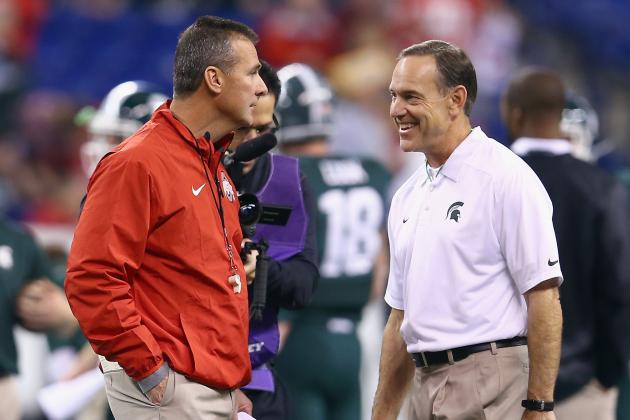
Ohio State HC Urban Meyer and Michigan State HC Mark Dantonio
Florida State HC Jimbo Fisher and Clemson HC Dabo Swinney
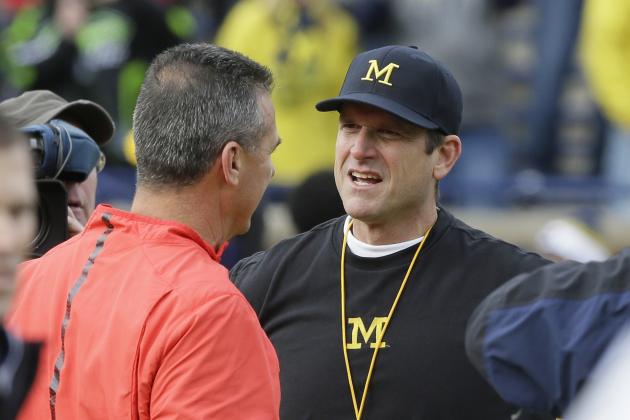
Ohio State HC Urban Meyer and Michigan HC Jim Harbaugh
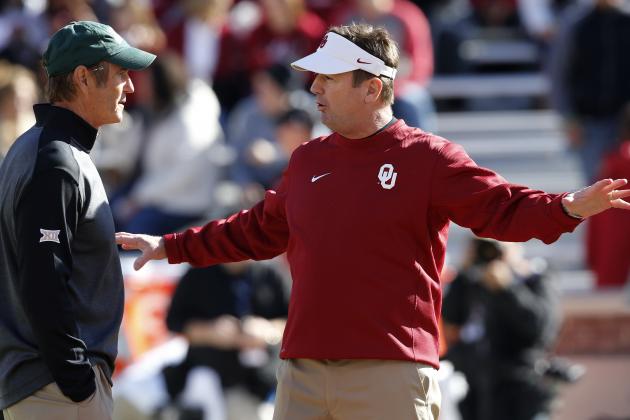
Baylor HC Art Briles and Oklahoma HC Bob Stoops
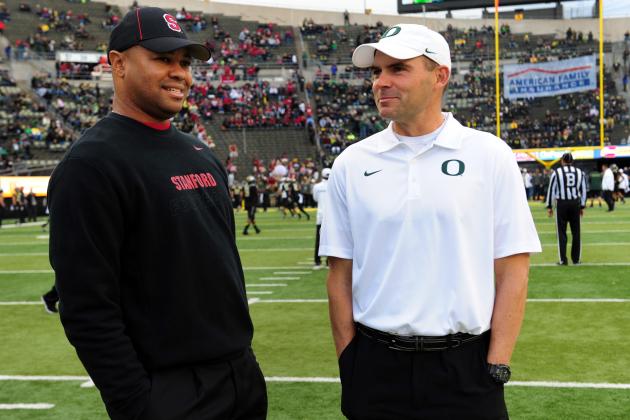
Stanford HC David Shaw and Oregon HC Mark Helfrich
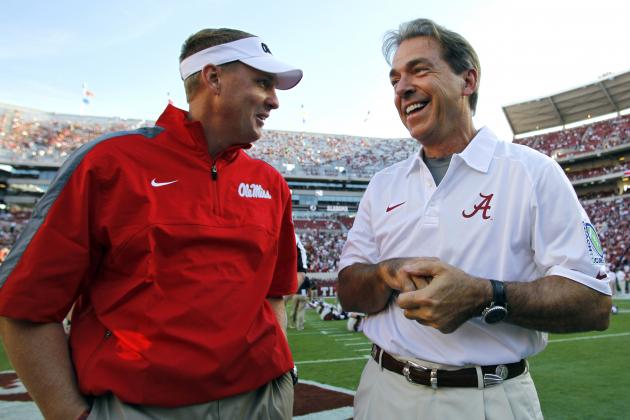
Ole Miss HC Hugh Freeze and Alabama HC Nick Saban
Every Power 5 College Football Conference's Perfect Coaching Staff – Bleacher Report
Andy Lyons/Getty Images
Richard Shiro/Associated Press
Carlos Osorio/Associated Press
Sue Ogrocki/Associated Press
Steve Dykes/Getty Images
Butch Dill/Associated Press